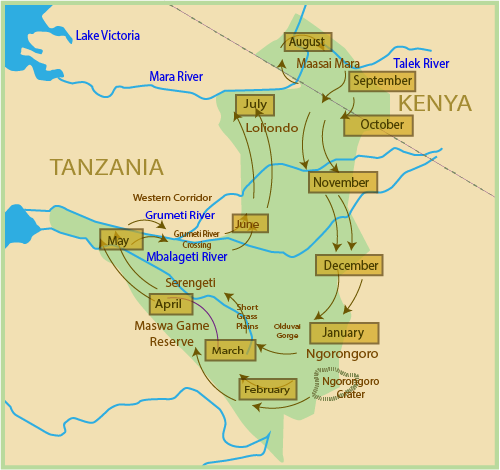Serengeti National Park
The park covers 14,763 sq km of endless rolling plains, which reach up to the Kenyan border and extends almost to Lake Victoria. The park is flourishing with magnificent wildlife. An estimated 3 million large animals roam the plains. People of the Maasai Tribe called it Siringitu – ‘the place where the land moves on forever.’ The Serengeti is known as one of the best wildlife sanctuary in the world.
Wildlife
The Serengeti boasts large herds of antelope including Patterson’s eland, Klipspringer, Dikdik, Zebra, gazelles, lion, impala, leopard, cheetah, hyena and other larger mammals like the rhino, giraffe, elephant and hippopotamus. Nearly 500 species of birds have been recorded in the park. The Serengeti is an opportunity for one of the best game-viewing in Africa.
Migration in the Serengeti
The wildebeest migration, like a discernible thread, embraces and connects the Serengeti’s ecosystem much as it has done for at least two millions years.
Every year, with some seasonally dictated variations in timing and scale, one million wildebeest leave the southern Serengeti’s short grass plains in search of the grass and water they need to survive.
Serengeti Migration Map
1. DECEMBER – MARCH
The calving: An estimated 400,000 calves are born which can draw a staggering number of predators eager to prey on the vulnerable young.
2. APRIL
The trek north: Herds move slowly northwards to fresh grazing.
3. MAY – JUNE
The rut: May is the mating season but still the journey continues, some herds move west towards the Grumeti River, and this is the first point on the route where river crossings can be seen.
4. JULY – OCTOBER
River crossings: The river crossings usually start in July, but the timing all depends on the rains. Although never guaranteed, crossings can regularly be seen at the Mara and Talek rivers.
5. NOVEMBER
The trek south: When the rains begin in November, the herds usually cross back to the Serengeti from the Masai Mara and head back towards the now fertile southern Serengeti. By the beginning of December, Ndutu starts seeing the herds return to calve, and the whole process begins again.

